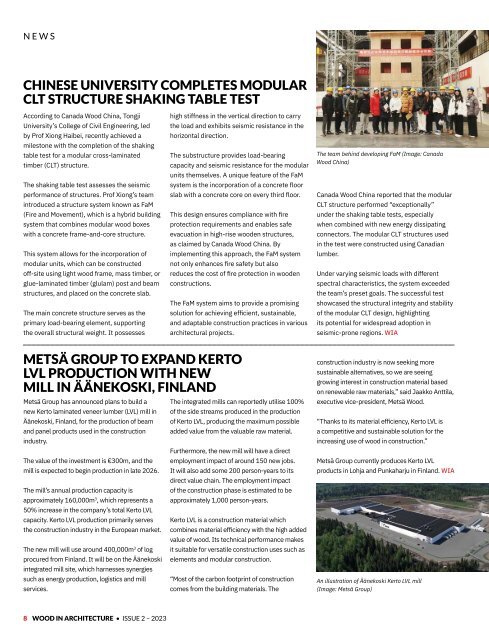WIA_ISSUE2_2023
You also want an ePaper? Increase the reach of your titles
YUMPU automatically turns print PDFs into web optimized ePapers that Google loves.
NEWS<br />
CHINESE UNIVERSITY COMPLETES MODULAR<br />
CLT STRUCTURE SHAKING TABLE TEST<br />
According to Canada Wood China, Tongji<br />
University’s College of Civil Engineering, led<br />
by Prof Xiong Haibei, recently achieved a<br />
milestone with the completion of the shaking<br />
table test for a modular cross-laminated<br />
timber (CLT) structure.<br />
The shaking table test assesses the seismic<br />
performance of structures. Prof Xiong’s team<br />
introduced a structure system known as FaM<br />
(Fire and Movement), which is a hybrid building<br />
system that combines modular wood boxes<br />
with a concrete frame-and-core structure.<br />
This system allows for the incorporation of<br />
modular units, which can be constructed<br />
off-site using light wood frame, mass timber, or<br />
glue-laminated timber (glulam) post and beam<br />
structures, and placed on the concrete slab.<br />
The main concrete structure serves as the<br />
primary load-bearing element, supporting<br />
the overall structural weight. It possesses<br />
high stiffness in the vertical direction to carry<br />
the load and exhibits seismic resistance in the<br />
horizontal direction.<br />
The substructure provides load-bearing<br />
capacity and seismic resistance for the modular<br />
units themselves. A unique feature of the FaM<br />
system is the incorporation of a concrete floor<br />
slab with a concrete core on every third floor.<br />
This design ensures compliance with fire<br />
protection requirements and enables safe<br />
evacuation in high-rise wooden structures,<br />
as claimed by Canada Wood China. By<br />
implementing this approach, the FaM system<br />
not only enhances fire safety but also<br />
reduces the cost of fire protection in wooden<br />
constructions.<br />
The FaM system aims to provide a promising<br />
solution for achieving efficient, sustainable,<br />
and adaptable construction practices in various<br />
architectural projects.<br />
The team behind developing FaM (Image: Canada<br />
Wood China)<br />
Canada Wood China reported that the modular<br />
CLT structure performed “exceptionally”<br />
under the shaking table tests, especially<br />
when combined with new energy dissipating<br />
connectors. The modular CLT structures used<br />
in the test were constructed using Canadian<br />
lumber.<br />
Under varying seismic loads with different<br />
spectral characteristics, the system exceeded<br />
the team’s preset goals. The successful test<br />
showcased the structural integrity and stability<br />
of the modular CLT design, highlighting<br />
its potential for widespread adoption in<br />
seismic-prone regions. <strong>WIA</strong><br />
METSÄ GROUP TO EXPAND KERTO<br />
LVL PRODUCTION WITH NEW<br />
MILL IN ÄÄNEKOSKI, FINLAND<br />
Metsä Group has announced plans to build a<br />
new Kerto laminated veneer lumber (LVL) mill in<br />
Äänekoski, Finland, for the production of beam<br />
and panel products used in the construction<br />
industry.<br />
The value of the investment is €300m, and the<br />
mill is expected to begin production in late 2026.<br />
The mill’s annual production capacity is<br />
approximately 160,000m 3 , which represents a<br />
50% increase in the company’s total Kerto LVL<br />
capacity. Kerto LVL production primarily serves<br />
the construction industry in the European market.<br />
The new mill will use around 400,000m 3 of log<br />
procured from Finland. It will be on the Äänekoski<br />
integrated mill site, which harnesses synergies<br />
such as energy production, logistics and mill<br />
services.<br />
The integrated mills can reportedly utilise 100%<br />
of the side streams produced in the production<br />
of Kerto LVL, producing the maximum possible<br />
added value from the valuable raw material.<br />
Furthermore, the new mill will have a direct<br />
employment impact of around 150 new jobs.<br />
It will also add some 200 person-years to its<br />
direct value chain. The employment impact<br />
of the construction phase is estimated to be<br />
approximately 1,000 person-years.<br />
Kerto LVL is a construction material which<br />
combines material efficiency with the high added<br />
value of wood. Its technical performance makes<br />
it suitable for versatile construction uses such as<br />
elements and modular construction.<br />
“Most of the carbon footprint of construction<br />
comes from the building materials. The<br />
construction industry is now seeking more<br />
sustainable alternatives, so we are seeing<br />
growing interest in construction material based<br />
on renewable raw materials,” said Jaakko Anttila,<br />
executive vice-president, Metsä Wood.<br />
“Thanks to its material efficiency, Kerto LVL is<br />
a competitive and sustainable solution for the<br />
increasing use of wood in construction.”<br />
Metsä Group currently produces Kerto LVL<br />
products in Lohja and Punkaharju in Finland. <strong>WIA</strong><br />
An illustration of Äänekoski Kerto LVL mill<br />
(Image: Metsä Group)<br />
8 WOOD IN ARCHITECTURE • ISSUE 2 – <strong>2023</strong>

















